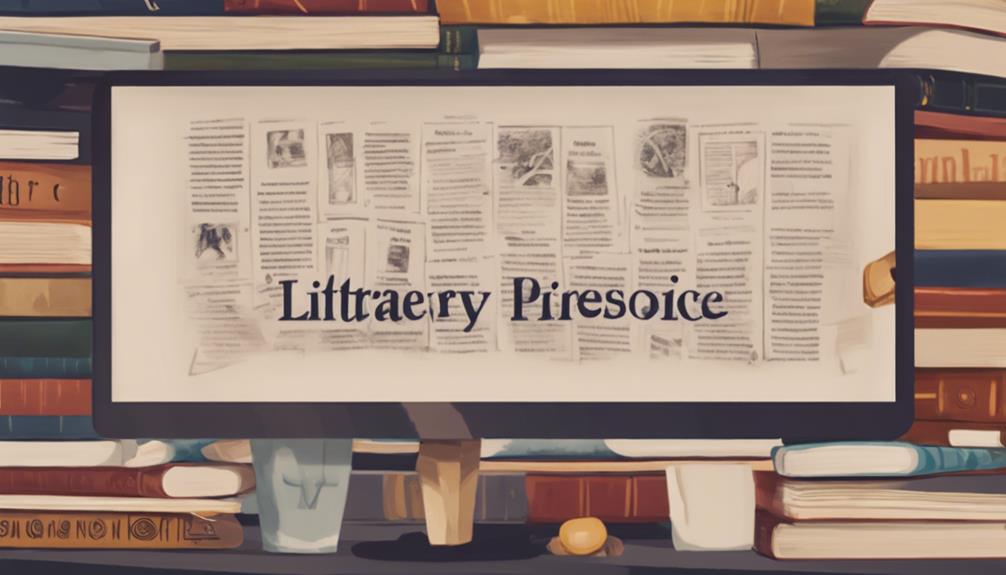Linguistic Features and Figurative Language
Figurative Language Vs. Literary Devices: What Sets Them Apart?
Fascinated by the nuances of language in literature? Explore how figurative language and literary devices differ in their creative expressions.

Figurative language and literary devices have unique roles. Figurative language paints vivid images using imaginative tools like similes and metaphors. It explores deeper meanings through creative expression, capturing readers' attention with vivid descriptions. On the other hand, literary devices like rhyme and alliteration focus on enhancing structure and musicality. They add layers of meaning and evoke specific emotions through strategic manipulation of language. Understanding their distinctions enhances our appreciation of literature and poetry. Exploring the nuances between them enriches our interpretation and analysis, offering insights into the diverse ways writers convey messages and feelings effectively.
Key Takeaways
- Figurative language focuses on imaginative comparisons and deeper meanings.
- Literary devices like rhyme and alliteration enhance structure and musicality.
- Figurative language adds layers of creativity and emotions to writing.
- Literary devices manipulate rhythm and mood for effective communication.
- Figurative language vividly conveys emotions and abstract concepts.
Definition of Figurative Language
Figurative language, as a literary tool, surpasses literal meanings to vividly convey ideas through imaginative devices like simile, metaphor, personification, hyperbole, and symbolism. These literary devices serve as the building blocks of creative expression, allowing writers to paint vivid pictures in the minds of readers.
Similes compare two unlike things using 'like' or 'as,' while metaphors directly equate two different concepts, adding depth and complexity to the narrative. Personification attributes human qualities to non-human entities, breathing life and personality into objects.
Hyperbole exaggerates for emphasis, creating dramatic effects and highlighting key points. Symbolism imbues objects with deeper meanings, enriching the text with layers of interpretation. The essence of figurative language lies in its ability to infuse writing with creativity, offering writers a rich tapestry of tools to craft compelling narratives and engage readers on a profound level.
Types of Figurative Language

Exploring various forms of figurative language reveals the diverse ways in which writers enhance their storytelling through creative linguistic devices. When delving into the domain of figurative language, one encounters a rich tapestry of techniques that add depth and beauty to poetry and prose.
Here are some key types to ponder:
- Rhyme: A poetic device where words have similar sounds, often at the end of lines, creating a musical quality that enhances the text's rhythm and memorability.
- Repetition: The intentional reuse of words or phrases for emphasis, creating a pattern that can evoke strong emotions or emphasize key ideas in the writing.
- Metaphorical Language: Comparing two unlike things directly to convey deeper meanings and create vivid imagery, allowing readers to see things in a new light.
- Personification: Giving human qualities to non-human entities, breathing life into descriptions and making them more engaging for the audience.
These techniques, along with others like hyperbole and symbolism, form the building blocks of figurative language, enriching writing across various genres and styles.
Examples of Figurative Language

In storytelling, figurative language serves as a powerful tool for creating vivid and engaging imagery that captivates readers' imagination. Simile, a common figure of speech, compares two unlike things using 'like' or 'as' to enhance descriptions. For example, 'Her eyes sparkled like diamonds in the sunlight.'
Metaphor, another figure of speech, directly compares two unlike things without 'like' or 'as,' conveying deeper meanings. An example is 'Time is a thief stealing moments from our lives.'
Personification gives human qualities to non-human entities, making descriptions more lively. A classic example is 'The wind whispered through the trees.'
Hyperbole uses exaggeration to emphasize a point or evoke emotions, like saying 'I've told you a million times.'
Imagery in figurative language paints vivid mental pictures, appealing to the senses and emotions of readers. By comparing two unlike things and moving beyond the literal meanings, figurative language adds depth and richness to storytelling.
Definition of Literary Devices

Literary devices, as essential components of effective writing, encompass specific techniques and structures utilized to convey meaning, enhance text, and evoke desired effects. These tools offer writers a way to explore language creatively, engaging readers on multiple levels.
Understanding literary devices allows readers to investigate deeper into the layers of meaning and emotion embedded within a text. Here is a breakdown of the key aspects of literary devices:
- Imagery: Utilizing vivid descriptions to paint a picture in the reader's mind, creating a sensory experience that enhances the text.
- Symbolism: Using symbols to represent ideas or qualities, adding depth and layers of meaning to the writing.
- Onomatopoeia: Incorporating words that mimic the sounds they describe, bringing aural texture and vividness to the narrative.
- Manipulation of Language: Employing various linguistic techniques to craft compelling narratives that resonate with the audience.
Types of Literary Devices

Moving from the foundational understanding of literary devices, we now shift our focus to exploring various types that enrich and enhance the fabric of written works.
Literary devices such as rhyme, alliteration, assonance, onomatopoeia, and repetition play vital roles in shaping the structure and rhythm of poems. Rhyme, a common literary device, involves the repetition of similar sounds at the end of lines, adding a musical quality to the piece.
Alliteration, on the other hand, repeats consonant sounds closely to create a rhythmic effect, enhancing the poem's flow. Assonance focuses on the repetition of vowel sounds within lines, creating internal rhymes that contribute to the overall structure and musicality.
Onomatopoeia brings sensory appeal by using words that imitate natural sounds, engaging the reader's auditory senses. Repetition, another essential device, emphasizes key words or phrases through their recurrence, reinforcing the poem's message and impact.
These devices work intricately within the structure of a poem, enhancing not only its aesthetic appeal but also its emotional depth and resonance.
Examples of Literary Devices

Literary devices, such as repetition, symbolism, and imagery, play an essential role in enhancing the depth and impact of a writer's work. These devices help create unique rhythms, evoke emotions, and engage readers in a more profound understanding of the text.
Types of Devices
Exploring various types of literary devices can deepen our understanding of how poets enhance their works with structure and musicality.
- Rhyme: Adds a musical quality by repeating similar sounds at the end of lines.
- Repetition: Emphasizes key ideas by repeating words, phrases, or structures.
- Consonance: Creates harmony by repeating consonant sounds within words.
- Simile, Metaphor, Personification: Enhance imagery and meaning by comparing things using 'like' or 'as' (simile), implying a direct comparison (metaphor), or attributing human qualities to non-human entities (personification).
These literary devices help poets create rhythm, convey emotions, and enrich their poetry with vivid descriptions, making the reading experience more engaging and profound.
Role in Writing
To enhance our writing and captivate readers, we employ various literary devices such as simile, metaphor, and personification to infuse our work with vivid comparisons and imaginative imagery. These tools help convey complex ideas concisely, making our writing more engaging.
For example, hyperbole allows for exaggeration, symbolism adds deeper meanings, and imagery paints sensory descriptions. By utilizing literary devices effectively, we can evoke emotions, simplify abstract concepts, and showcase our unique style and voice.
Understanding and applying these devices elevate the quality of our writing, making it more compelling and memorable to readers. Through the use of figurative language, including similes, metaphors, personification, hyperbole, symbolism, and imagery, we can craft narratives that resonate deeply with our audience.
Effect on Readers
As we explore the impact of literary devices on readers, we uncover how these tools intricately weave emotions and vivid imagery into the fabric of written works, creating lasting impressions that resonate deeply within the audience.
- Literary devices like simile and metaphor evoke powerful emotions, making readers connect to the text on a personal level.
- Sound devices such as alliteration and onomatopoeia engage readers by creating a rhythmic flow and enhancing the overall mood of a piece.
- The strategic use of literary devices influences readers' perceptions, shaping their understanding and interpretation of the content.
- Through the employment of figurative language and literary devices, writers effectively convey complex ideas, leaving a profound impact on readers and enriching their reading experience.
Contrasting Figurative Language and Literary Devices

Comparing figurative language with literary devices reveals distinct differences in their functions and effects on written works. Figurative language, including simile and metaphor, emphasizes imaginative comparisons and deeper meanings through vivid imagery. On the other hand, literary devices such as rhyme and alliteration focus on enhancing the structure and musicality of poetry. While figurative language adds layers of creativity and emotions, literary devices manipulate rhythm and mood to convey meaning more effectively.
Figurative language plays a vital role in conveying emotions and abstract concepts by painting vivid pictures in the reader's mind. In contrast, literary devices create a specific cadence and flow, enhancing the overall reading experience. Understanding these distinctions helps us appreciate how figurative language enriches the text with symbolic depth, while literary devices contribute to the aesthetic and structural aspects of poetry. By recognizing these differences, readers can better grasp the unique contributions each makes to literary works, ultimately enhancing their overall impact.
Importance in Poetry

Enhancing the depth and emotional resonance of poetry, figurative language plays an essential role in engaging readers through vivid imagery and unique perspectives. When it comes to the importance of figurative language and literary devices in poetry, several key aspects stand out:
- Enhanced Imagery: Figurative language in poetry paints vivid pictures in the reader's mind, making the verses come alive with sensory details and descriptive language.
- Evoking Emotions: By using literary devices like symbolism and metaphor, poets can tap into readers' emotions, creating a powerful connection that resonates long after the poem is read.
- Unraveling Interpretation: Analyzing figurative language requires readers to explore deeper into the text, uncovering hidden meanings and revealing layers of interpretation that enrich the overall experience.
- Structural Support: Poetic devices such as rhyme and alliteration not only add musicality to poems but also provide structural support, enhancing the flow and rhythm of the verses.
Understanding and appreciating the significance of figurative language and literary devices in poetry is important for readers seeking to fully immerse themselves in the artistry and creativity of poetic expression.
Frequently Asked Questions
What Is the Difference Between Language Devices and Literary Devices?
When distinguishing between language and literary devices, it's important to recognize their unique roles.
Language devices focus on the structure and expression of language, aiding in effective communication.
On the other hand, literary devices encompass a broader spectrum of tools, including language devices, utilized to enhance the depth and impact of a text.
Understanding these differences is key to analyzing texts thoroughly.
What Is the Difference Between Figure of Speech and Literary Device?
When it comes to the difference between figure of speech and literary device, we need to understand that figures of speech are specific types of figurative language involving comparisons or associations, while literary devices encompass a broader range of techniques to enhance writing.
While figures of speech are creative ways to convey ideas, literary devices include elements like rhyme and rhythm to enrich the overall structure and meaning of a literary work.
What Is the Difference Between Literary Terms and Devices?
When it comes to distinguishing between literary terms and devices, the key lies in their unique functions. Literary terms are specific and technical, focusing on elements like rhyme and meter.
On the other hand, literary devices are more about techniques used to enhance meaning and style. Understanding these distinctions helps us explore further into analyzing structure and creativity in writing.
Are Rhetorical Devices and Figurative Language the Same Thing?
Yes, rhetorical devices and figurative language aren't the same. Rhetorical devices are used to persuade or communicate effectively, while figurative language adds layers of meaning and imagery.
Rhetorical devices aim to influence or engage an audience, while figurative language appeals to emotions and imagination. Understanding these distinctions enhances our ability to analyze and appreciate different forms of communication.
Conclusion
Just as the sun gives light to the world, figurative language illuminates the beauty of language, while literary devices serve as the guiding stars of literature. Together, they create a tapestry of words that captivate and inspire readers.
Understanding the nuances between these two elements is key to revealing the true power of language in poetry and beyond. Embrace the richness of figurative language and the precision of literary devices to fully appreciate the artistry of words.
Boaz, Founder and Chief Editor – With a profound linguistics and anthropology background, founded What Does Meanings to explore the intricate connections between language, symbols, and cultural identity. His vision has guided the platform from its inception, ensuring that each piece of content enriches our understanding of the world’s symbolic heritage.
Linguistic Features and Figurative Language
How Does Diction Imagery and Figurative Language Develop Tone?
Get ready to explore how diction, imagery, and figurative language intertwine to shape the emotional tone of poetry.

In poetry, diction, imagery, and figurative language work together to create tone. Diction, or word choice, sets the emotional tone and conveys the poet's attitude. Imagery paints vivid pictures that evoke feelings and set the mood. Figurative language, like metaphors and personification, adds depth and layers of meaning. Together, they craft a pivotal role in shaping the overall emotional impact of the poem. Understanding how these components interact can enhance your appreciation of poetry.
Key Takeaways
- Diction shapes mood and emotion, setting the tone with word choice.
- Imagery creates sensory experiences, adds depth, and guides emotional response.
- Figurative language like metaphors and personification enhances tone layers.
- Careful language choices in diction, imagery, and figurative language shape tone.
- Connotations, symbolism, and vivid descriptions contribute to tone development.
The Impact of Diction on Tone
Diction shapes the overall mood and emotional landscape of a poem, impacting tone through the selection of specific words. The words chosen, also known as word choice, play a critical role in conveying the intended tone of the poem. Different levels of formality, complexity, and emotional depth can be achieved through the careful selection of words. By using various figures of speech such as metaphors, similes, and personification, poets can further enhance the tone established by diction. These figures of speech add layers of meaning and evoke specific emotions in the reader, contributing to a richer tone experience.
Analyzing the diction in a poem provides insights into subtle tone shifts, helping readers navigate the nuances of voice and emotional expression woven into the text. The precision and thoughtfulness behind word choices reveal the poet's intention and guide the audience's interpretation of the poem's tone and underlying messages.
Enhancing Tone Through Imagery

When it comes to enhancing tone through imagery, vivid descriptions play a key role in creating a sensory experience for the reader.
Symbolism adds depth to the text, allowing for multiple layers of interpretation.
Metaphors, in particular, have the power to evoke strong emotions and enrich the overall tone of the piece.
Vivid Imagery Impact
Enhancing tone through vivid imagery in poetry involves creating visual representations that stir emotions and establish a distinct emotional landscape within the poem. By utilizing detailed and descriptive imagery, poets can guide the reader's emotional response and shape the overall tone of the piece.
Figurative language, such as similes and metaphors, further enhances the impact of imagery by presenting comparisons that evoke unexpected connections and deeper meanings. Through the use of strong imagery, poets can immerse the audience in sensory experiences, making the tone more engaging and impactful.
The combination of vivid imagery, figurative language, and a carefully crafted tone creates a powerful poetic experience that resonates with readers and lingers in their minds long after the words have been read.
Symbolism Depth Added
Adding layers of depth and meaning to poetry, symbolism in imagery serves to intricately weave abstract concepts and emotions into a tangible and relatable framework. Symbolism plays a pivotal role in enhancing the tone of a poem by infusing it with deeper significance.
Through carefully chosen symbols, poets can convey complex ideas and evoke specific emotions, inviting readers to explore the underlying themes. By incorporating symbolism in imagery, poets establish connections between different elements, enriching the reader's interpretation and understanding of the tone.
This use of symbolic language guides the reader through a journey of discovery, encouraging them to investigate the hidden layers of meaning within the text. Ultimately, symbolism in imagery helps create a cohesive and evocative tone that resonates with the reader's emotions and perceptions.
Metaphors Evoke Emotions
Using metaphors in poetry vividly compares two unlike things to evoke emotions and enhance the overall tone. Metaphors in poetry have a significant impact on the reader, stirring deep emotions and creating lasting impressions. Here's why they're so essential:
- Emotional Depth: Metaphors add layers of emotion to the poem, allowing readers to connect on a profound level.
- Imagery Enhancement: Through metaphors, poets can paint vivid pictures in the reader's mind, evoking strong emotions and enhancing the overall imagery.
- Tone Shaping: Metaphors play a pivotal role in shaping the tone of the poem, setting the mood and guiding the reader's emotional response.
Metaphors not only enrich the reader's experience but also provide a deeper understanding of the poet's intended emotions and themes.
Figurative Language and Tone Development

Figurative language in poetry plays a pivotal role in shaping the emotional depth and atmosphere of the piece, ultimately influencing the overall tone. When using personification, objects and animals are endowed with human-like characteristics, evoking a sense of familiarity and connection for the reader. For instance, in the line 'The wind whispered secrets through the trees,' the wind is personified, creating a mystical and intimate tone.
Diction, combined with figurative language, further refines the tone by establishing the poet's attitude towards the subject. By carefully selecting words that carry specific connotations, the poet guides the reader's interpretation of the poem's emotional landscape. For example, describing a storm as 'ferocious' versus 'powerful' can drastically alter the tone from one of fear to one of awe.
Connotations and Tone Creation

In poetry, the selection of words with specific connotations is essential for crafting the desired tone. When considering how language is used in a literary work, connotations play an important role in creating the overall tone of the piece. Here are three key points to understand the significance of connotations in tone creation:
- Emotional Impact: Connotations in diction can evoke a range of emotions, influencing how readers interpret the mood of the poem. Words with positive connotations may elicit feelings of joy or hope, while those with negative connotations can evoke sadness or criticism.
- Perception of Mood: The positive or negative connotations of words shape the reader's perception of the poem's mood. Careful selection of words with specific connotations is necessary to convey the intended tone effectively.
- Tone Establishment: Diction choices with negative connotations can create a somber or critical tone, whereas words with positive connotations can establish a hopeful or optimistic tone in the literary work. Each word selected contributes to the overall tone and impact of the poem.
Creating Atmosphere With Descriptive Language

Crafting an atmospheric experience in poetry involves skillfully weaving descriptive language, which utilizes diction, imagery, and figurative language to immerse readers in a sensory journey. By carefully selecting words and crafting vivid imagery, poets can transport readers to different worlds and evoke a range of emotions. The use of figurative language, such as similes, metaphors, and personification, adds depth and complexity to the atmosphere, enriching the overall tone of the poem.
Specific details and sensory descriptions play a pivotal role in establishing the mood and ambiance of a poem. Through the power of imagery, poets can paint vibrant scenes that resonate with readers on a visceral level. Diction, imagery, and figurative language work in harmony to create a rich and immersive atmosphere within the poem, allowing readers to fully engage with the emotions and experiences being portrayed. Mastering the art of descriptive language is key to crafting poems that resonate with audiences and leave a lasting impact.
Metaphors and Tone in Writing

Metaphors in writing serve as powerful tools to enhance the emotional impact of our words.
They allow us to make abstract concepts more tangible and relatable to our audience.
Impact of Metaphors
Enhancing the tone of writing, metaphors compare two distinct elements in a figurative manner, infusing text with vivid imagery and emotional depth. When considering the impact of metaphors on writing, it's crucial to understand their significance:
- Emotional Resonance: Metaphors evoke specific emotions, creating a deeper connection with the reader.
- Complex Ideas: They help convey intricate concepts in a concise and impactful way, enhancing the overall message.
- Tone Shifting: Effective metaphors can alter the tone of the writing, shifting it from lighthearted to serious, thereby influencing the reader's perception and engagement with the text.
Tone Through Comparisons
We explore how comparisons through metaphors can profoundly shape the tone of our writing, engaging readers on emotional and intellectual levels. Metaphors in writing serve as powerful tools to convey complex emotions and ideas by likening one concept to another.
By employing metaphors, writers can add layers of meaning to their work, allowing readers to investigate further into the text and extract subtle nuances. These comparisons create vivid imagery that resonates with the audience, evoking specific feelings and associations.
Through skillful use of metaphors, the tone of a piece can be transformed, guiding readers towards a particular interpretation. Metaphors contribute greatly to the overall tone of a composition, enriching it with depth and evocative imagery.
Using Similes to Shape Tone

How can similes be effectively utilized to shape the tone in poetry?
Similes play an important role in crafting the tone of a poem by drawing comparisons between disparate elements. Here are three ways similes can shape tone in poetry:
- Enhancing Imagery:
Similes create vivid imagery by likening one thing to another, allowing readers to visualize and experience the emotions conveyed in the poem more intensely.
- Conveying Emotions:
By comparing two unlike things, similes help to express a wide range of emotions, moods, and attitudes within a poem, influencing the overall tone and connecting with the reader on an emotional level.
- Inviting Interpretation:
Skillful use of similes in poetry encourages readers to make imaginative connections between different concepts, enriching the language and adding layers of meaning that contribute to shaping the tone of the poem.
Evoking Emotions With Language Choices

Drawing upon the emotional depth of language choices is a pivotal tool in shaping the tone of poetry, as it intricately weaves the fabric of feelings within the reader's experience. Diction plays a vital role in evoking emotions by selecting words that resonate with the reader's sensibilities.
The careful use of descriptive language can elicit a range of feelings, from joy to sorrow, from calmness to excitement. Imagery further enhances this emotional journey by painting vivid pictures that stir the reader's imagination. By appealing to the senses through detailed descriptions, poets can create a rich emotional landscape that envelops the reader.
Additionally, figurative language, such as metaphors and similes, adds layers of meaning and depth to the emotional tapestry of a poem. Through creative comparisons, poets can evoke complex emotions and provoke introspection in their audience. The harmonious interplay of diction, imagery, and figurative language is instrumental in crafting a poem that resonates with the reader on an emotional level.
Crafting Effective Tone Through Language

Crafting an effective tone through language requires precise diction, vivid imagery, and creative use of figurative language. To achieve this, consider the following:
- Diction: Carefully select words based on their formality, complexity, and origin. The choice of words can greatly influence the overall tone of a poem, setting the mood and guiding the reader's interpretation.
- Imagery: Create visual representations and sensory experiences through vivid descriptions. Imagery plays a pivotal role in shaping the emotional landscape of a stanza, evoking specific feelings and enhancing the reader's connection to the text.
- Figurative Language: Incorporate similes, metaphors, and other forms of figurative language to add depth and convey emotions in unexpected ways. By comparing elements in unique and creative ways, figurative language enriches the reader's experience and contributes to the overall tone of the poem.
Frequently Asked Questions
How Does Diction Develop Tone?
When looking at how diction shapes tone, we see that word choice plays a pivotal role. The selection of words, including their complexity, formality, and origin, directly influences the overall mood of a piece.
How Does Diction Contribute to the Development of Figurative Language and Imagery?
In crafting poetry, diction, imagery, and figurative language intertwine to create a tapestry of meaning.
Diction, with its precise word choice, acts as the cornerstone, influencing how vivid images are painted and metaphors are sculpted. Through carefully selected words, we breathe life into the poem, setting the stage for a symphony of emotions.
This harmonious blend shapes the tone, guiding readers through a journey of words that resonate deep within.
How Figurative Language Creates Tone?
Figurative language, like metaphors and similes, shapes the tone of a poem by creating unexpected comparisons. Personification attributes human qualities to non-human things, influencing the emotional landscape. Hyperbole intensifies the tone and emphasizes the poet's emotions.
These elements contribute to the overall mood, guiding interpretations and evoking specific emotions. By crafting vivid imagery through figurative language, poets enhance the tone, setting the mood, and conveying underlying themes effectively.
How Do Diction Imagery and Figurative Language Develop the Tone in Stanza 3?
In stanza 3, diction, imagery, and figurative language work together to sculpt the tone with precision.
Each word choice, vivid image, and creative comparison strategically blend to evoke a specific emotional response from readers.
This deliberate crafting of language in stanza 3 guarantees that the tone resonates deeply and guides our understanding of the poem's underlying themes.
Conclusion
To sum up, the art of crafting tone through diction, imagery, and figurative language is a subtle yet powerful tool in writing. By carefully choosing our words, painting vivid pictures with imagery, and incorporating figurative language, we can create a tone that resonates with our readers.
It's a delicate balance of creativity and precision, but when done right, it can enhance the overall impact of our writing. So next time you pick up a pen, remember the power of language in shaping tone.
Boaz, Founder and Chief Editor – With a profound linguistics and anthropology background, founded What Does Meanings to explore the intricate connections between language, symbols, and cultural identity. His vision has guided the platform from its inception, ensuring that each piece of content enriches our understanding of the world’s symbolic heritage.
Linguistic Features and Figurative Language
Mastering Figurative Language to Help Characterize
Mastery of figurative language transforms characters, adding depth and emotion – discover how to captivate readers with vivid portrayals.

Mastering figurative language enriches character portrayal remarkably. It instills depth, evokes emotions, and forms strong connections with readers. Different types like metaphors, similes, and personification offer varied ways to enhance character traits vividly. Similes, for instance, highlight unique qualities through comparisons with objects. Metaphors explore deeper by drawing insightful parallels. Enhance characters greatly by incorporating figurative language skillfully. Additional details on how to effectively use these techniques await.
Key Takeaways
- Utilize metaphors and similes to compare characters to objects or animals.
- Employ personification to make characters vivid and relatable.
- Use hyperbole to exaggerate character traits for emphasis.
- Incorporate symbolism for deeper meanings and character development.
- Employ unique figurative language to add complexity and aid in character development.
Importance of Figurative Language in Characterization
Figurative language enriches character development by infusing depth and complexity into their traits and personalities. Through the use of metaphors, similes, and personification, characters come to life in a way that allows readers to connect with them on a profound level. Comparisons and vivid descriptions create a multi-dimensional portrayal that goes beyond surface characteristics, revealing the intricacies of their inner worlds.
Metaphors, like a character being described as 'a beacon of hope in a sea of despair,' evoke powerful imagery that conveys underlying emotions and motivations. Similes, such as 'as fierce as a lion in battle,' paint a vivid picture of a character's strength and determination. Personification can transform non-human characters into relatable beings by attributing human qualities to them.
Types of Figurative Language for Characterization

We use metaphors to add depth to characters, comparing them to objects or concepts.
Similes help us highlight specific traits by likening characters to familiar things using 'like' or 'as'.
Personification breathes life into characters by giving human qualities to non-human entities they interact with.
Metaphors for Depth
Drawing upon comparisons between characters and other entities, metaphors serve as potent tools in characterizing individuals by delving into their deeper traits and emotions. When crafting metaphors for depth in characterization, various types can be utilized to convey different aspects of a character's persona. Here is a breakdown of the types of metaphors commonly employed for character development:
| Type of Metaphor | Description | Example |
|---|---|---|
| Conventional Metaphors | Standard comparisons used to symbolize traits or emotions in a straightforward manner. | "Her heart was a fortress." |
| Creative Metaphors | Innovative comparisons that offer unique insights into a character's nature. | "His laughter was a symphony." |
| Extended Metaphors | Elaborate comparisons that are sustained throughout a narrative, enriching character depth. | "Life is a journey, and he was stuck at a crossroads." |
| Catachresis | Unconventional or strained metaphors that push the boundaries of comparison for impact. | "The idea blossomed in her mind." |
Similes for Comparison
Similes for comparison illuminate characters by juxtaposing them with objects or qualities, using 'like' or 'as' in writing. These comparisons create vivid imagery, helping readers visualize characters' traits, emotions, or relationships.
Effective similes highlight unique characteristics, motivations, or dynamics among characters. By incorporating similes in characterization, writers add depth, complexity, and relatability to fictional characters.
Mastering similes in figurative language is essential for developing rich and dynamic characters in storytelling. As writers, we should aim to utilize similes thoughtfully to enhance the reader's understanding and connection to the characters we create.
Through skillful use of similes, characters can come to life in ways that resonate with audiences and make stories more engaging.
Using Similes and Metaphors for Characterization

When crafting characters in writing, employing similes can paint vivid descriptions that bring individuals to life on the page.
Metaphors, on the other hand, can reveal deeper traits by drawing direct comparisons without the use of 'like' or 'as.'
Similes for Vivid Description
Comparing characters to familiar objects or concepts through similes offers a powerful tool for crafting vivid and relatable descriptions that enhance characterization. Similes allow us to make imaginative comparisons that highlight specific traits and create visual images, aiding in character development.
By using similes, writers can evoke emotions, making characters more memorable with distinct personalities. Mastering similes is key to enhancing characterization by adding depth, richness, and uniqueness to how characters are portrayed.
These comparisons not only help readers visualize characters more clearly but also feel a deeper connection to them, ultimately enriching the overall reading experience and making the characters more engaging and lifelike.
Metaphors to Reveal Traits
Exploring metaphors in characterization reveals traits more deeply by drawing insightful comparisons between characters and other elements, enriching the understanding of their personalities and motivations.
Metaphors, unlike similes, don't use 'like' or 'as' but directly equate the character to another object or idea, creating a stronger connection.
By incorporating metaphors in character descriptions, writers can add layers of meaning and complexity to their characters, making them more compelling and relatable. These comparisons help readers visualize character traits through vivid imagery, painting a clearer picture of who the character is at their core.
Through the skillful use of metaphors, writers can provide a deeper insight into the motivations and personalities of their characters, ultimately enhancing the overall depth and richness of the narrative.
Character Depth Through Comparisons
Utilizing similes and metaphors enhances character depth by seamlessly weaving unique comparisons into their descriptions, fostering a deeper connection between readers and the characters themselves.
When authors employ figurative language for characterization, they paint vivid imagery that helps readers visualize the character's personality and traits. Similes compare a character to something else using 'like' or 'as,' while metaphors create direct comparisons without these words.
Through creative comparisons, similes and metaphors add layers of depth and complexity to characters, making them more relatable and engaging. These comparisons can reveal hidden aspects of a character's motivations, emotions, and unique qualities, enriching the reader's understanding of the character's persona.
Enhancing Character Traits With Figurative Language

By infusing character descriptions with metaphors and similes, we can paint a more vibrant picture and deepen readers' connection to the characters. When we use figurative language like metaphors or similes to describe character traits, we can create vivid images that stay with the reader long after they finish the story. Personification, on the other hand, gives characters human qualities, making them relatable and engaging. Hyperbole, though exaggerated, can emphasize the importance of certain character traits dramatically. Symbolism adds layers of meaning to characters, making their portrayal more complex and intriguing. Mastering figurative language in character description is essential for crafting memorable characters that resonate with readers. Let's explore how these elements work together in the table below:
| Figurative Language | Description |
|---|---|
| Metaphors | Compare character traits for vivid imagery |
| Similes | Use comparisons to enhance understanding |
| Personification | Give human qualities to characters |
| Hyperbole | Exaggerate traits for emphasis |
| Symbolism | Add deeper meanings and complexity to characters |
Conveying Emotions Through Figurative Language

To effectively convey characters' emotions, figurative language serves as a powerful tool for encapsulating their innermost feelings through vivid descriptions and comparisons. Figurative language plays an important role in character development by adding layers of depth to their emotional experiences.
Here are three key ways in which figurative language can help in conveying emotions:
- Metaphors: Using metaphors allows writers to draw parallels between the character's emotions and concrete objects or concepts, creating a rich tapestry of feelings.
- Similes: By incorporating similes, writers can make direct comparisons between the character's emotions and other relatable experiences, enhancing the reader's understanding.
- Personification: Personifying emotions gives them human-like qualities, making them more tangible and easier for readers to empathize with.
Mastering the art of figurative language, including metaphors, similes, and personification, is essential for effectively portraying characters' emotions and immersing readers in their emotional journeys.
Tips for Effective Characterization Through Figurative Language

Conveying characters' emotions effectively through figurative language involves employing various techniques such as metaphors, similes, personification, and other creative devices to deepen their portrayal and engage readers in their emotional journey. By using metaphors and similes, we can compare characters to objects or animals, enhancing their traits and personalities. Personification gives characters human-like qualities, making them more relatable and vivid. Hyperbole allows for the exaggeration of character traits or actions, adding dramatic effect and emphasis. Symbolism is instrumental in representing deeper meanings or character development through objects or symbols. Experimenting with unique and creative figurative language not only adds depth and complexity to character descriptions but also aids in character development. Effective characterization is achieved by mastering the art of using these literary devices in creative writing to craft compelling and memorable characters.
| Literary Device | Description |
|---|---|
| Metaphors | Compare characters to objects or animals to enhance their traits |
| Similes | Draw comparisons to enrich characters' personalities |
| Personification | Give characters human-like qualities for relatability |
| Hyperbole | Exaggerate traits or actions for dramatic effect |
| Symbolism | Use objects or symbols to represent deeper meanings |
Frequently Asked Questions
How Do You Master Figurative Language?
To master figurative language, we practice regularly, experiment with unique comparisons, seek feedback, study examples in literature, and use various types like metaphors, similes, and personification.
It's about honing our skills, being creative, and learning from others. By doing this, we enhance our writing and add depth to our characters.
What Are the Characteristics of Figurative Language?
Figurative language includes metaphors, similes, and personification to add depth and enhance storytelling. It goes beyond literal meanings to convey emotions and create vivid imagery.
By using figurative language, writers can show rather than tell, letting readers interpret characters' traits and emotions more vividly. This technique helps characterize by making descriptions more unique and complex.
Understanding and mastering figurative language is essential for creating memorable characters in literature and storytelling.
What Is the Best Way to Describe Figurative Language?
When it comes to describing figurative language, the best approach involves highlighting its power to create vivid imagery and convey deeper meanings.
By using similes, metaphors, and personification, writers can infuse characters with unique traits and emotions.
Figurative language enhances characterizations by painting a more detailed and nuanced picture of their inner thoughts and motivations.
Mastering these techniques is essential for crafting compelling and multi-dimensional characters that resonate with readers on a profound level.
How Do You Use Figurative Language to Describe the Setting?
We use figurative language to describe the setting by painting vivid pictures with words, stirring emotions with metaphors and similes, and giving life to inanimate objects through personification.
By employing symbolism, we add layers of meaning to the setting, enhancing the story's depth.
Hyperbole, used sparingly, can exaggerate aspects of the setting for emphasis or to provoke specific reactions.
These techniques bring richness and depth to our descriptions, captivating the reader's imagination.
Conclusion
To sum up, mastering figurative language is essential for creating rich and dynamic characters in literature. Just like a sculptor molds clay, writers use similes and metaphors to shape characters with depth and complexity.
By using figurative language effectively, authors can bring their characters to life, allowing readers to truly connect with them on a deeper level.
So remember, figurative language is like the paintbrush to a masterpiece, adding vibrant colors and intricate details to your characters.
Boaz, Founder and Chief Editor – With a profound linguistics and anthropology background, founded What Does Meanings to explore the intricate connections between language, symbols, and cultural identity. His vision has guided the platform from its inception, ensuring that each piece of content enriches our understanding of the world’s symbolic heritage.
Linguistic Features and Figurative Language
Why Is Figurative Language Essential for You to Use in Writing?
Kindle your writing with the magic of figurative language to ignite imagination and captivate readers with its transformative power.

Incorporating figurative language into writing is crucial for enhancing reader engagement, adding depth to narratives, evoking emotions effectively, creating vivid imagery, boosting memorability, conveying complex ideas clearly, improving overall writing quality, making content relatable, and enhancing creativity. These benefits enrich the reader's experience and make your writing more impactful. Each figure of speech paints a unique picture, stirs emotions, and fosters a deeper connection with your audience. By utilizing figurative language, you breathe life into your words and captivate your readers in ways that straightforward language cannot. Explore the depth and richness it adds to your writing.
Key Takeaways
- Enhances reader engagement by creating vivid mental images and evoking strong emotional responses.
- Adds depth to writing, engaging readers intellectually and emotionally with impactful descriptions.
- Evokes emotions effectively, fostering empathy and understanding through vivid imagery.
- Creates vivid imagery that appeals to the senses, making scenes vibrant and engaging.
- Boosts memorability by improving communication clarity, conveying complex ideas with lasting impressions.
Enhances Reader Engagement
Enhancing reader engagement through the use of figurative language involves creating vivid mental images that captivate and resonate with the audience. Figures of speech, such as similes and metaphors, play an essential role in this process. By incorporating these literary devices into our writing, we can evoke strong emotional responses from our readers, making the content more memorable and impactful.
When we infuse our writing with figurative language, we provide readers with a multi-sensory experience that stimulates their imagination. This not only captures their attention but also helps them connect more deeply with the subject matter. For instance, a well-crafted metaphor can transform a complex idea into something relatable and easily understood. By painting a picture with words, we invite readers to immerse themselves in our narrative, fostering a sense of engagement and curiosity.
In essence, figurative language serves as a powerful tool for enhancing reader engagement by creating an emotional resonance that lingers long after the words have been read.
Adds Depth to Writing

Figurative language imbues writing with layers of meaning that transcend the surface, inviting readers into a domain where words dance with deeper significance. By utilizing literary devices such as metaphors, similes, and personification, writers can express meaning in a way that goes beyond the literal interpretation of words. These imaginative expressions not only engage readers intellectually but also emotionally, creating a more profound connection between the text and the audience.
When writers incorporate figurative language into their work, they enhance the impact of descriptions, making them more vivid and memorable. This added depth helps convey abstract ideas in a relatable manner, allowing readers to grasp complex concepts more easily. Through the use of literary devices, writers can add complexity and richness to their storytelling, elevating their work to a higher level of artistry. Essentially, figurative language serves as a powerful tool for writers to explore the depths of human experience and evoke thought-provoking interpretations from their readers.
Evokes Emotions Effectively

Figurative language allows us to tap into the power of emotions, creating a profound impact on our readers. Through vivid imagery and evocative language, we establish a strong connection that resonates with their feelings.
This emotional engagement enhances the overall experience of our writing, making it more memorable and impactful.
Emotional Impact
In harnessing the power of figurative language, writers can skillfully evoke a range of emotions, fostering a deep connection between the reader and the text. Figurative language adds a layer of depth and richness to writing, allowing for a more nuanced and evocative expression of emotions.
By employing figures of speech, writers can vividly capture the essence of various emotions, making their writing engaging and memorable. This evocative language stirs up empathy, sympathy, joy, sadness, and a myriad of other emotions in readers.
Through the artful use of figurative language, writers can effectively convey complex emotions in a relatable and impactful manner, enhancing the overall emotional impact of their writing.
Connection With Readers
Ultimately, figurative language serves as a bridge that links writers and readers through the shared experience of emotions. Figurative language has the power to evoke emotion and draw readers into the writer's world, creating a strong bond through shared feelings and experiences.
By using metaphors, similes, and other forms of figurative language, writers can tap into the readers' emotions, making the content more relatable and engaging. This emotional connection allows readers to connect on a deeper level, fostering empathy and understanding.
Through vivid descriptions and sensory language, figurative language paints a picture that resonates with readers, eliciting powerful responses and leaving a lasting impact.
Creates Vivid Imagery

Creating vivid imagery in writing captivates readers' imagination, immersing them in a sensory-rich experience. Through the use of figurative language, writers can paint detailed mental images that evoke emotion and bring their narratives to life.
Here's how vivid imagery enhances the reader's experience:
- Engagement of Senses: Descriptions enriched with figurative language appeal to the senses, allowing readers to see, hear, smell, taste, and touch the world within the text.
- Emotional Connection: Vivid imagery stirs emotions within readers, eliciting empathy, excitement, or nostalgia as they explore the story.
- Enhanced Descriptions: Figurative language adds depth and complexity to descriptions, transforming mundane scenes into vibrant, memorable snapshots.
- Immersive Reading Experience: By creating a vivid mental landscape, writers transport readers into the heart of the narrative, making them active participants in the storytelling process.
Incorporating figurative language not only makes writing more engaging but also leaves a lasting impression on readers, making the text more relatable and impactful.
Boosts Memorability

Figurative language boosts memorability by enhancing reader engagement, sparking creativity, and improving communication clarity.
When we use metaphors and similes in our writing, we help readers connect emotionally to the content, making it more likely to stick in their minds.
This technique guarantees that our message isn't only understood but also remembered long after it's been read.
Enhances Reader Engagement
Enhancing reader engagement and boosting memorability, the use of figurative language in writing creates impactful imagery that fosters emotional connections with the text. When employing figurative language, consider these benefits:
- Vivid Descriptions: Paint a picture with words, allowing readers to visualize the scene.
- Emotional Resonance: Evoke feelings and empathy, making the writing more relatable.
- Enhanced Understanding: Clarify complex ideas by using familiar comparisons.
- Lasting Impressions: Leave a mark on readers' minds, ensuring they remember the content.
Sparks Creativity
By igniting creativity and enhancing memorability, the use of figurative language in writing captivates readers with its imaginative depth. Creative metaphors and similes, when used effectively, can breathe life into writing, making it more engaging and memorable.
Figurative language allows writers to express complex ideas in a way that sparks the reader's imagination, creating vivid and lasting impressions. It helps writers stand out by infusing their work with originality and depth.
Improves Communication Clarity
Improving communication clarity and boosting memorability, the use of figurative language in writing captivates readers with its vivid and memorable descriptions.
Figurative language:
- Enhances communication clarity by creating vivid imagery.
- Engages readers through imaginative descriptions.
- Helps in better retention of information due to its memorable nature.
- Makes the message impactful by evoking emotions and creating lasting impressions.
Conveys Complex Ideas Clearly

To simplify intricate concepts in writing, figurative language serves as a powerful tool through comparisons and imagery. By using metaphors and similes, writers can convey complex ideas clearly, making them more accessible to readers. Let's explore how figurative language helps in conveying complex ideas:
| Metaphor | Simile |
|---|---|
| Compares two different things directly | Compares two different things using 'like' or 'as' |
| Creates a stronger connection between the two subjects | Enhances the understanding of abstract concepts |
| Helps readers visualize abstract ideas | Makes complex ideas more relatable and understandable |
Metaphors and similes are like keys that open the door to intricate concepts, allowing writers to guide readers through complex terrain with ease. Through these comparisons, readers can grasp challenging ideas without feeling overwhelmed. Figurative language is not just a stylistic choice; it is a powerful means to clarify and illuminate the most intricate of thoughts.
Improves Overall Writing Quality

Enhancing the overall quality of our writing, figurative language adds depth, creativity, and richness to our written work. When we incorporate different types of figurative language, we elevate our writing to new heights. Here's how it improves our overall writing quality:
- Metaphors: Comparing two unlike things directly, metaphors create vivid imagery and evoke emotions effortlessly.
- Similes: By using 'like' or 'as' to draw comparisons, similes make descriptions more relatable and understandable.
- Personification: Giving human traits to non-human entities, personification breathes life into our writing, making it more engaging.
- Hyperbole: Exaggerating for emphasis, hyperbole adds flair and drama to our writing, leaving a lasting impact on the reader.
Through the skillful use of these types of figurative language, we can enhance the beauty, expressiveness, and impact of our writing, showcasing our mastery and captivating our audience effectively.
Makes Writing More Relatable

Using figurative language in writing humanizes inanimate objects or abstract concepts, making the content more relatable and engaging for readers. By incorporating familiar comparisons, such as describing the wind as a playful child or a heartache as a stormy sea, writers create an emotional connection that resonates with readers on a personal level.
Through these relatable comparisons, readers can better understand complex ideas or emotions by linking them to experiences they already know. For example, describing a challenging task as a mountain to climb helps readers grasp the difficulty and effort required. This emotional connection draws readers into the text, sparking empathy and interest in the subject matter.
Figurative language not only enhances the reader's comprehension but also fosters a deeper engagement with the writing. By bridging the gap between abstract concepts and concrete experiences, writers can evoke a range of emotions, from joy to sorrow, creating a more immersive and memorable reading experience.
Enhances Creativity

Creativity blossoms as figurative language sparks our imaginations, enabling us to express ideas in innovative and imaginative ways. When we explore the domain of figurative language, particularly through tools like similes, our writing takes on new dimensions:
- Thinking Outside the Box: Figurative language encourages us to investigate unconventional ways of presenting ideas, pushing us beyond the boundaries of traditional expression.
- Fresh Perspectives: By incorporating similes and metaphors, writers can offer readers unique viewpoints that challenge their thinking and evoke emotions.
- Breaking Clichés: Figurative language helps us steer clear of overused phrases and clichés, fostering originality and creativity in our writing.
- Adding Depth: Through personification and other figurative elements, writers can infuse their work with layers of meaning, creating a richer and more engaging reading experience.
When we embrace figurative language in our writing, we open the door to a world where creativity thrives, ideas flourish, and our words resonate with depth and originality.
Frequently Asked Questions
Why Is Figurative Language Important in Writing?
Figurative language is essential in writing as it enhances meaning and engages readers.
It helps convey abstract concepts vividly, making the text more memorable and relatable.
By evoking emotions and creating vivid mental images, it adds clarity and impact to our writing.
Through sounds, scents, tastes, and touch, figurative language brings our words to life, making them more engaging and resonant with our audience.
How Does Figurative Language Support the Writer's Purpose?
Figurative language supports the writer's purpose by enhancing communication. It adds depth, making ideas more engaging and memorable.
Through vivid imagery, readers are captivated and emotionally connected. Abstract concepts become relatable, increasing the impact of the message.
Figurative language allows for effective conveyance of complex ideas and emotions.
What Is the Benefit of Knowing Figurative Language?
Understanding figurative language benefits us in numerous ways. It enhances critical reading skills, aids in making inferences, and deepens comprehension of literary works.
Analyzing similes and metaphors helps us grasp authors' intentions and develop critical thinking. Regular exposure to figurative language improves literacy and communication skills, expanding our language proficiency.
In short, knowing figurative language is essential for enhancing our ability to interpret and appreciate written works effectively.
What Is the Main Reason the Author Uses Figurative Language?
Using figurative language in writing enhances the emotional impact, engages readers, and creates vivid descriptions. It adds depth and complexity to storytelling, making abstract ideas relatable.
Figurative language appeals to readers' senses and emotions, making the writing more memorable. By incorporating metaphors, similes, and other forms of figurative language, the author can convey complex ideas in a more engaging and impactful manner.
Conclusion
To sum up, figurative language is absolutely essential for writing. Without it, our words would fall flat, lacking the depth, emotion, and vivid imagery that captivate readers.
It enhances our creativity, improves the quality of our writing, and makes complex ideas easier to understand.
In short, figurative language isn't just a tool, but a necessity for anyone looking to truly connect with their audience and leave a lasting impact.
Boaz, Founder and Chief Editor – With a profound linguistics and anthropology background, founded What Does Meanings to explore the intricate connections between language, symbols, and cultural identity. His vision has guided the platform from its inception, ensuring that each piece of content enriches our understanding of the world’s symbolic heritage.
-

 Cultural and Historical Symbols1 month ago
Cultural and Historical Symbols1 month agoExploring Crosses and Their Meanings in Depth
-

 Modern Symbols and Signs1 month ago
Modern Symbols and Signs1 month agoSubaru's Dashboard Symbols Unraveled: 10 Meanings
-

 Modern Symbols and Signs1 month ago
Modern Symbols and Signs1 month agoIs Five Guys Closing Permanently? The True Story
-

 Spiritual and Esoteric Meanings1 month ago
Spiritual and Esoteric Meanings1 month agoUnveiling Bird Poop on Car Spiritual Meaning
-

 Modern Symbols and Signs1 month ago
Modern Symbols and Signs1 month agoUnderstanding Innovatively Meaning – Dive In!
-

 Spiritual and Esoteric Meanings1 month ago
Spiritual and Esoteric Meanings1 month agoWedding Dream Meaning Death: Unveiling Symbols
-

 Linguistic Features and Figurative Language1 month ago
Linguistic Features and Figurative Language1 month agoDecoding Figurative Language: Understanding Rhetorical Devices
-

 Artistic and Decorative Symbols1 month ago
Artistic and Decorative Symbols1 month agoUnderstanding pp Mean on Sheet Music Dynamics


















